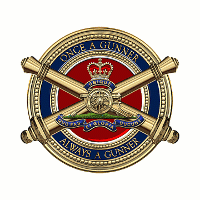QX 33652 Gunner Stanley Rasmussen served in the 2/4th Field Regiment AIF for the last 18 months of the Second World War.
Stan was a strongly loyal bloke who became one of the stalwarts of the Brisbane 2/4th Field Regiment Association. I met him in 1992 when he first came to a luncheon at the Sherwood Services Club. This followed his seeing the 2/4th marching banner on ANZAC Day earlier in the year and joining the boys for that parade.
After that, Stan was hooked with the camaraderie of the 2/4th group. He became a regular attendee at the luncheons and ANZAC Day parades. When his health prevented his marching the full distance, Mick Heffernan recalled how Stan would wait with the ladies outside the Daniels Hotel and join the boys as they passed, thus shortening his march.
Stan was 23 years of age when he enlisted in the coastal artillery militia in August 1940 as Q49387. He did his initial training with 122nd Heavy Battery and shot at Cowan Battery on Moreton Island.
He was called up for full time service in January 1941 when manning fixed defences to protect the sea routes in the Torres Straits became a military priority. Gunner Stan was sent to the Milman Battery Coastal Artillery on Thursday Island.
The nearby Horn Island became an important air strip and the area sustained Japanese bombing raids accordingly. Otherwise, life on Thursday Island was fairly dull and routine so in July 1942, Stan decided he wanted a part of the offensive action.
Tom Guilfoyle tells of how he just beat Stan into the queue for the AIF and they ended up with consecutive regimental numbers, Stan becoming QX 33652.
However, it was another 12 months before they were posted down to the Bribie Island Coast Artillery Battery. The Brisbane Line was a reality at this time and the high priority given to the coast defence of Brisbane prevented Stan from being released to the AIF. Slowly, the threat to Australia disappeared and the AIF divisions began moving up to the Atherton Tablelands for tropical training.
There was a huge farewell march for the AIF's 7th Division through Brisbane in early August 1944. Just after that, Stan was posted to the 2/4th Field Regiment as a 25-Pounder gun number in 8th Battery. He moved with this unit to the Tablelands and began the rigorous training for the amphibious 'island hopping' campaigns.
Suddenly it was May 1945 and they were on the move again—Stan went to Townsville, and was shipped to Morotai where the 2/4th polished up its amphibious landing techniques.
Late in June 1945, Stan and the 8th Battery embarked for a final rehearsal before sailing to Borneo. On 1 July, following a massive sea and air bombardment, Stan's battery was the first artillery ashore near Balikpapan and, after wrestling their guns across the beach, became the first to fire a shot in support of the advancing infantry.
The 7th Division moved northwards with the batteries leap-frogging forward. Stan and his mates worked hard and long hours and days till the news of the atomic bombs being dropped on Japan was received in early August.
Stan's war had come to an end. Their guns were handed over to the force destined for Japan's occupation, sports and relaxation became the order of the day. Stan was flown home to Brisbane and discharged on 13 December 1945.
Others people will tell you of Stan's return to civvy street, his marriage to Jean and his life till and after retirement. Apart from some contact with Tom Guilfoyle and regular beers after work in the Valley with his fellow gunner mate Horrigan, Stan's contact with the 2/4th Field Regiment lapsed till 1992 when he saw their marching banner on ANZAC Day.
Stan and Jean became an integral part of the quarterly Sherwood luncheons. Stan was not a loud vocal supporter, but his continued presence, quiet words and gratitude to anyone who assisted the old veterans were an example to others who enjoyed far better health than he did.
I remember Stan craftily placing bets at the Transcontinental Hotel reunions when I was running the two-up for the 2/4th. I remember him smiling happily at the Theodore Club after his last ANZAC Day march. I remember his always being there at the Sherwood luncheons.
Service as a gunner in the 2/4th was the climax of Stan's war and he never forgot his unit or his mates. He will not be forgotten and I, in particular, will not forget him.
Vale Stan Rasmussen.
Arthur Burke OAM
Queensland Secretary
2/4th Field Regiment Association
20 September 2007 RAAHC |


